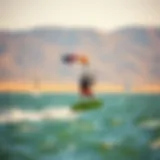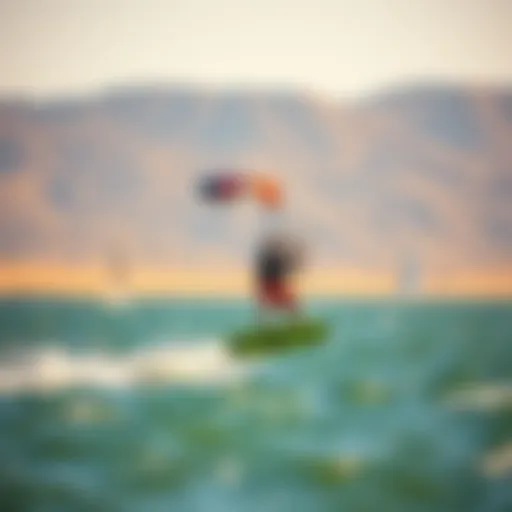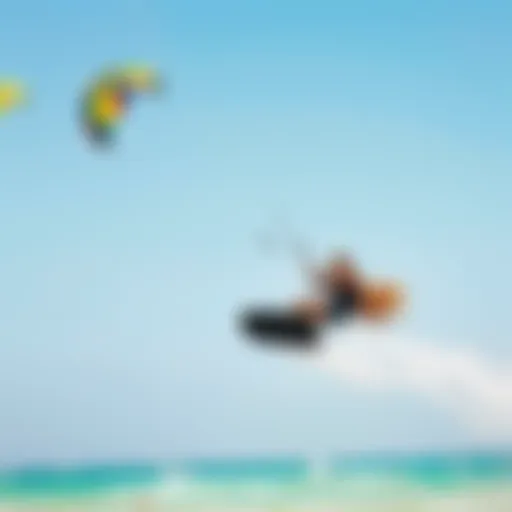Top Kitesurfing Kites for Beginners: A Comprehensive Guide


Intro
Kitesurfing is rapidly becoming a highly sought-after sport, attracting thrill-seekers and adventurers alike. If you find yourself drawn to the allure of harnessing wind power to glide across the water, then you’re in for a treat. However, diving into this exhilarating experience without the right knowledge can make it feel like you're sailing against the wind. This is where the importance of choosing the right kite comes into play.
The good news is that choosing a beginner kite doesn’t have to be a shot in the dark. In this guide, we'll unpack the essential features of kites designed for newcomers, spotlight our top recommendations, and provide clarity on how to select the best kite that suits your needs.
Whether you’re dreaming of riding the waves in Tarifa or the serene lakes of the Midwest, the right kite can make all the difference in your learning journey. Getting familiar with kite types, sizes, and designs is just as crucial as understanding safety measures and local conditions. This article aims to arm you with knowledge so you can confidently choose your first kite and get started on your kitesurfing adventure.
Gear Insights
Latest Gear Reviews
When it comes to kitesurfing gear for beginners, the selection can be overwhelming. Recent reviews consistently underline the importance of stability and user-friendly designs in beginner kites. Models like the Duotone Neo and North Reach have emerged as popular choices in the community, praised for their performance even in less-than-ideal conditions. These kites provide that perfect balance which beginners need—they won’t throw you off even on a windy day, allowing plenty of room to learn.
Additionally, many kites now come equipped with rapid depower features. What this means for beginners is that you have more control during those inevitable trial-and-error moments. Set your eyes on kites with broad wind ranges to ensure that you can take advantage of varying conditions as you grow and develop your skills.
Essential Gear for Beginners
While the kite itself often takes center stage, don’t overlook the supporting equipment that contributes to a safer and more enjoyable ride. Here are a few essentials you should consider:
- Harness: A good harness is fundamental. Look for something comfortable and secure, such as the ION Kite Harness which is known for its ergonomic design.
- Board: Your choice of board should reflect your skill level. Beginners benefit from larger boards, like the Liquid Force Drive, which provides stability and ease during learning.
- Safety Gear: Helmets and impact vests may seem like overkill, but they can save you from unexpected falls and minor miscalculations. Brands like Cabrinha often have reliable options that blend safety with comfort.
- Wetsuit: Depending on where you plan to kite, a wetsuit is crucial for warmth and protection from impacts. The O’Neill Epic wetsuit is a popular choice thanks to its flexibility and warmth.
"In kitesurfing, confidence is your best ally. The right gear not only enhances performance but also boosts your morale as you learn."
With these insights, you'll certainly be better equipped to grab the right kite and get ready for your first adventure on the water.
Techniques and Tips
To embrace kitesurfing fully, you must also familiarize yourself with some techniques and tips to ensure safety and maximize your enjoyment in this thrilling sport. We will delve into that in the next sections.
Understanding Kitesurfing
Kitesurfing, at first glance, may just look like a daring sport that combines elements of surfing and flying a kite. However, as you peel back the layers, you’ll find that it's a multifaceted activity requiring an in-depth understanding of various components. In this article, we delve into the foundational elements of kitesurfing, laying the groundwork for beginners to grasp what makes this sport not only accessible but thrilling.
Prologue to Kitesurfing
Kitesurfing, also known as kiteboarding, is a water sport that marries the thrill of surfing with the control and excitement offered by a power kite. Essentially, a kitesurfer rides on a board while being pulled by the kite. This dynamic interaction with wind and water provides a unique blend of enjoyment, challenge, and, at times, sheer exhilaration.
For many, kitesurfing represents not just a recreational activity but a lifestyle. The camaraderie found in the kitesurfing community is palpable. From local beach spots to exotic travel destinations, you will find people who share the common passion of harnessing the wind and the waves.
But, to get started, understanding how all components work together is crucial. The kite is a pivotal element—it could be the difference between soaring through the air and a catastrophic wipeout. Thus, knowing the ins and outs of kitesurfing is imperative for a safe and enjoyable experience.
The Importance of Choosing the Right Kite
When setting out on the path of becoming a kitesurfer, the selection of a kite is one of the most significant decisions a beginner will make. The right kite can make learning smoother and more enjoyable, while the wrong choice may lead to frustration or, even worse, accidents.
Here are several factors to consider when selecting a kite for beginners:
- Size: Kites come in various sizes, and the appropriate size relates directly to your weight, skills, and the wind conditions of your chosen location. A larger kite can generate more lift, which is beneficial for light winds, while smaller kites are easier to control in strong winds.
- Design: For beginners, stable and user-friendly kite designs are vital. A good kite will have predictable responses and solid stability, particularly during those initial learning curves when control is paramount.
- Durability: The material used in a kite impacts its longevity. Beginners may not have the finesse required to handle kites gently, so opting for durable materials can save on costs in the long run.
- Handling and Control: Kites with a smoother and more responsive handling are generally preferable. These characteristics will help alleviate the steep learning curve that many face while trying to master the mechanics of kitesurfing.
Choosing a kite that ticks all these boxes ensures a smoother transition into the sport. The goal is not just to learn how to stay afloat, but to gain confidence and truly enjoy the ride.
"The right kite can make the difference between a glorious day on the water and a frustrating struggle to stay upright."
Understanding kitesurfing means appreciating its intricacies. Knowing how to select the right kite will ultimately empower beginners to take firm strides towards mastering this extraordinary sport.
Key Features of Beginner Kites
When you're just starting with kitesurfing, the choice of kite can make all the difference between a thrilling adventure and a harrowing experience. Understanding the key features of beginner kites not only enhances your enjoyment but also ensures safety and stability on the water. Diving into the specifics of size, design, material, and control, this section lays the groundwork for what you need to know when selecting your first kite.
Size Considerations
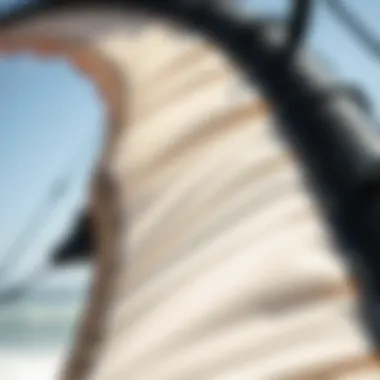
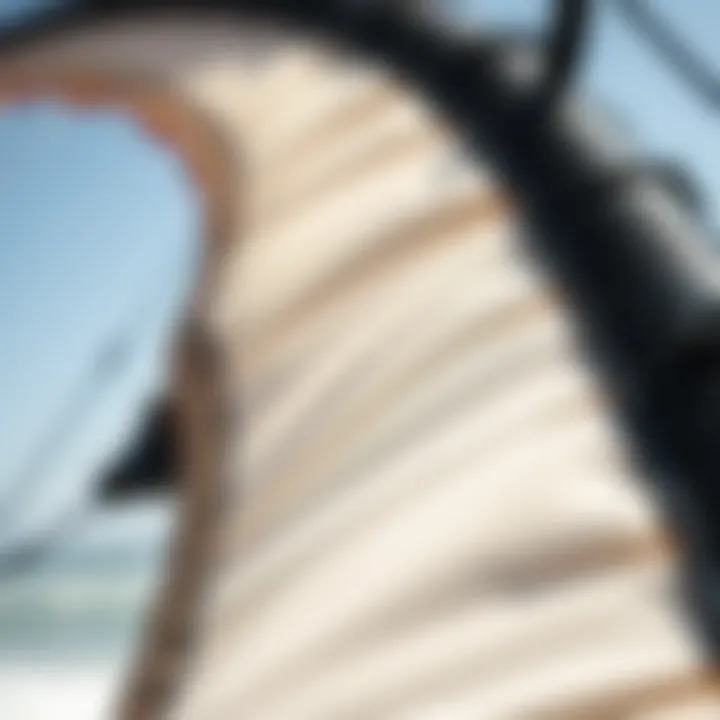
One of the pivotal factors when choosing a kite is its size. For beginners, typically, a larger kite—usually ranging from 9 to 12 meters—offers a more forgiving experience. Larger kites can catch the wind more effectively, which translates into better lift and stability. If the wind is light, a bigger kite will keep you afloat without exhausting your energy too quickly. However, be careful, because if the winds pick up, a larger kite can be more challenging to manage.
- Wind Conditions: Match the kite size to your local wind conditions. Heavier winds call for smaller kites.
- Body Weight: Personal weight matters too; heavier individuals may benefit from larger kites while lighter riders might find smaller options more suitable.
Finding the right size helps you stay in control and enjoy your first time on the waves. Since you're new, consider starting with a kite that balances lift and ease of handling comfortably.
Design and Stability
A kite’s design is more than just an aesthetic choice; it plays a crucial role in performance. Beginner kites often feature a delta shape or a C-shape, each providing distinctive handling characteristics. Delta-shaped kites are generally better for newbies due to their wide wingspan and stability in various wind conditions. They’re like that great friend who’s always there to catch you when you fall.
- Stability: Look for kites with a flat design, as they offer more stability. This stability helps riders maintain control while learning.
- Power Delivery: A kite that delivers consistent power helps beginners focus on their riding technique rather than struggling with sudden shifts in pull.
In essence, stability in design translates to confidence for a beginner. Ensuring your kite isn’t just flashy but functional can make learning much more enjoyable.
Material and Durability
The kite's material greatly influences its longevity and performance. Kites for beginners are often made from durable fabrics like ripstop nylon or polyester. These materials not only withstand wear and tear from crashes but also resist the elements like saltwater and sun exposure. Given that the ocean can be unforgiving, a resilient kite can save you from frequent replacements.
- Weight vs. Durability: A lightweight kite may seem appealing, but don’t compromise on durability. You'll want a kite that balances both qualities.
- Seams and Stitching: Inspect seams; well-stitched areas enhance the kite's ability to hold up against rigorous use.
Selecting a well-constructed kite means you'll spend more time riding the waves and less time dealing with repairs or worse, buying new kites too frequently.
Ease of Control and Handling
Beginners need kites that are easy to control and forgiving of mistakes. A kite that responds smoothly to inputs is crucial for novice riders, allowing them to learn without being overwhelmed. Look for kites with shorter bridle lines and simplistic setups; these features can significantly ease your learning curve.
- Bar Pressure: Kites that provide light bar pressure are typically easier to control, reducing fatigue while learning.
- Turning Radius: A tight turning radius will allow you to make adjustments easily and navigate more smoothly as you get your bearings in the water.
In sum, the simplicity and responsiveness of your kite will help you focus more on refining your skills and less on managing your gear. Every kite has its quirks, but choosing one with beginner-friendly handling can really help you enjoy the thrill of kitesurfing.
Top Recommendations for Beginner Kites
Choosing the right kite is paramount for those just dipping their toes into the world of kitesurfing. This section zeroes in on top kite models that suit the unique needs of beginners. A well-chosen kite can significantly enhance your learning curve, ensuring you gain the confidence needed to master this exhilarating sport. Each recommended kite not only exemplifies stability and ease of control but also offers a reliable design that instills safety and fun. Let’s dive into the details of these standout models,
Kite One: Overview and Features
Kite One emerges as a compelling option for novices eager to explore kitesurfing. With a size range ideally suited for various wind conditions, it thrives in environments that might intimidate less experienced pilots. Its dual-strut design provides necessary lift while maintaining a solid balance, reducing the chances of back-stalling for those still refining their skills. The textured fabric enhances durability against wear, which is vital as beginners often face rough starts. Key features include:
- Easy Relaunch: Designed to be user-friendly, allowing the rider to get back in the air quickly after a fall.
- Stability: It remains true and calm in higher winds, making it forgiving for beginners still mastering their control.
- Reinforced Leading Edge: Offers added durability when handling rough conditions.
Kite Two: Overview and Features
Next on the list is Kite Two, which has carved a reputation for crafting beginner-friendly kites that don’t skimp on performance. This kite features an adjustable size that caters to various skill levels, making it a quick favorite in the heart of new kiteboarders. The standout quality about Kite Two is its lightweight frame that aids responsiveness and maneuverability, critical for those first attempts at jumping and turns. Notable aspects include:
- Adjustable Settings: Perfect for customizing the kite’s performance as skills improve.
- User-Centered Design: Ensures that both the beginner and intermediate kitesurfers can easily handle it.
- Sustainability Assurance: Made with eco-friendly materials, supporting responsible practices in sporting equipment.
Kite Three: Overview and Features
Kite Three presents an innovative design focused on beginner needs but does not sacrifice excitement. It features a slightly wider wingspan, providing additional lift and power, which is crucial for those wanting to catch more wind. Its colorway choices also help in visibility, an often overlooked aspect that adds to safety on the water. Important features include:
- Increased Lift: Helps beginners get up on the board faster and with less hassle.
- Visual Clarity: Bright designs aid in tracking the kite from afar, which is beneficial in crowded conditions.
- Wind Range Versatility: Suitable for various wind conditions, giving learners more opportunities to practice.
Kite Four: Overview and Features
Kite Four offers a user-friendly experience, making the steep learning curve of kitesurfing feel more approachable. It has been reported that this model is particularly efficient in light wind conditions, enabling beginners to take their initial flights with ease. The key features include:
- Progressive Control Bar: Simplifies steering, allowing novices to feel in command of their kite.
- Durable Construction: Built to take on the inevitable bumps and scrapes that come with learning.
- Quick Installation: Setting up this kite is a breeze, a significant plus for new users frazzled on the beach.
Kite Five: Overview and Features
Lastly, we examine Kite Five, known for its high performance across various skill levels but especially favored amongst learners. This kite demonstrates excellent balance and easy control, making it less daunting for beginners still getting used to the wind’s erratic poetry. Features of Kite Five include:
- Simplicity in Design: Focused on delivering functional elements without the complications of intricate features.
- Stability in Turbulent Winds: It stays grounded, avoiding frequent dips and dives that might dishearten new riders.
- Enhanced Feedback: Insights into wind direction and speed help beginners become more attuned to their environment.


Whether you lean towards stability, ease of use, or even style, these kites offer a variety of features tailored to help new kiteboarders find their footing in this thrilling sport. Remember to always consider your local wind conditions and personal comfort when selecting a kite.
"A kite not only carries the rider but also shapes their journey in the winds of kitesurfing."
Assessing Local Conditions for Kiteboarding
Understanding the local conditions for kiteboarding is as vital as picking the right kite. If the weather and water do not cooperate, even the finest equipment won't make a difference. Having a good grasp of local factors like wind patterns and water conditions can directly influence a beginner's experience and safety on the water.
Properly assessing these conditions can help you to avoid dangerous situations and ensure that you have the right setup for the day. As a beginner, it's crucial to be proactive in learning how to read the environment around you before heading out.
Wind Patterns and Speeds
Wind is the lifeblood of kitesurfing. The wind patterns and strengths can vary greatly depending on your location and time of day. A pretty day might give you a false sense of security, but if you don’t understand what the wind is doing, you could be courting trouble.
Most areas have ideal wind speeds for kitesurfing, typically ranging between 12 to 25 knots. Anything below or above this can be tricky for a novice. Strong winds can lead to difficulty in controlling the kite, while light winds may not generate enough power to get you up and riding.
Key Tips for Assessing Wind Conditions:
- Know the Ideal Speed: Familiarize yourself with the optimal wind speed for your kite size. This varies by model but staying between the 12-25 knots range is a safe bet.
- Observe the Environment: Look for flags or trees in the area—they can give you a sense of wind direction and force.
- Online Resources: Use websites like Windy or Windfinder to get real-time updates on wind speeds and conditions before heading out.
Water Conditions: Flat vs. Choppy
The state of the water plays a significant role in how you’ll experience kitesurfing.
Two primary conditions affect your ride: flat water and choppy water. If you’re a beginner, it’s advisable to seek out flat or mildly wavy water. Flat water provides a smooth ride, making it easier to control the kite, balance on the board, and practice various techniques. In contrast, choppy water can create obstacles, making it challenging to maintain balance and control.
Here are things to keep in mind:
- Flat Water: Great for learning and practicing new skills. Look for lakes or bays that offer calm conditions.
- Choppy Water: Might be more exciting once you’ve gained some experience, but it can lead to more falls and a tougher learning curve. Be ready to manage the extra bounce and unpredictability.
Remember: The combination of wind and water conditions makes for a unique riding experience. Always prioritize safety by understanding both elements.
In summary, taking the time to gauge your local conditions can substantially enhance not just your enjoyment but also your safety while learning. Use local knowledge to your advantage, engage with seasoned riders, and watch how they navigate various conditions. It’s not just about the kite; it’s also about respecting the elements.
Safety Considerations for Beginners
Safety in kitesurfing is not just a suggestion; it's a necessity. For beginners especially, understanding the nuances of safety can mean the difference between a thrilling experience and one that's fraught with potential hazards. As you embark on this exhilarating journey, familiarizing yourself with safety protocols, wind dynamics, and the right gear is paramount for an enjoyable ride.
Understanding Wind Windows
One of the most critical aspects every novice kitesurfer should grasp is the concept of the wind window. This term refers to the specific area in the sky where the kite can be flown effectively. If you're picturing a large cutout in the sky that resembles a semicircle, you're on the right track. The wind window is an imaginary area that extends downwind in front of you and above your head.
Flying your kite in the wind window requires a keen understanding of how shifting winds can affect your ride. When the kite is positioned at the edge of the wind window, it will generate less pull. Conversely, when it’s pulled in close to the center of the window, you’ll feel much more force. This is precisely why it’s important to keep the kite within a controlled range.
Here are a few tips to keep in mind when navigating the wind window:
- Position Awareness: Always be aware of the kite's position in relation to the wind direction. It can result in effortless control when executed correctly.
- Practicing with a Trainer Kite: Before hitting the waves, practice flying a smaller trainer kite. This offers invaluable experience in managing the kite within the wind window.
- Stay Calm Under Pressure: In unpredictable wind conditions, keeping a level head is vital. Panic may lead to poor decisions that can heighten risks.
"Kitesurfing is like a dance with the wind. You can't force it; you have to feel it and move with it."
Essential Safety Gear
Equipping yourself with the proper safety gear cannot be overstated. As a beginner, buying a quality harness, helmet, and appropriate flotation device is essential. Having the right tools not only enhances your comfort but also significantly increases your safety while on the water.
Here's a closer look at the essentials:
- Helmet: Protecting your head is critical. An appropriate kitesurfing helmet should fit snugly without moving during your ride. It shields you from impacts, especially during falls.
- Impact Vest: This isn't just for buoyancy but is also designed to protect your torso from sudden impacts with the water or your board. Make sure it offers adequate flotation while still allowing free movement.
- Harness: You’ll need either a waist or seat harness to attach the kite control bar securely. Waist harnesses offer more freedom of movement, while seat harnesses can be more comfortable for beginners.
- Safety Leash: Attaching a safety leash to your kite is another layer of safety. This acts as a fail-safe in case you lose control of the kite.
- Sun Protection: Though it might not seem immediately relevant to safety, a solid sunscreen will protect against harmful UV rays during your lengthy sessions on the water.
When you prioritize safety gear, it fosters a more enjoyable learning environment. Beginners can focus on mastering techniques and enjoying their learning experience without being overwhelmed by unnecessary accidents.
Learning Resources for Beginners
Gaining knowledge and honing skills when starting kitesurfing is paramount. With this exhilarating sport comes a unique set of skills and an understanding of the dynamics of wind, water, and kite. Therefore, exploring various learning resources is essential for crafting a safe and enjoyable experience on the water. This section focuses on the potential avenues a newcomer can explore to improve their kitesurfing abilities, engage in the right practices, and understand essential safety measures.
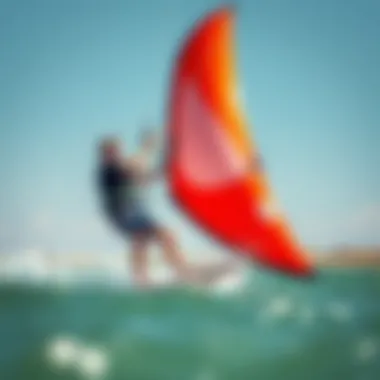
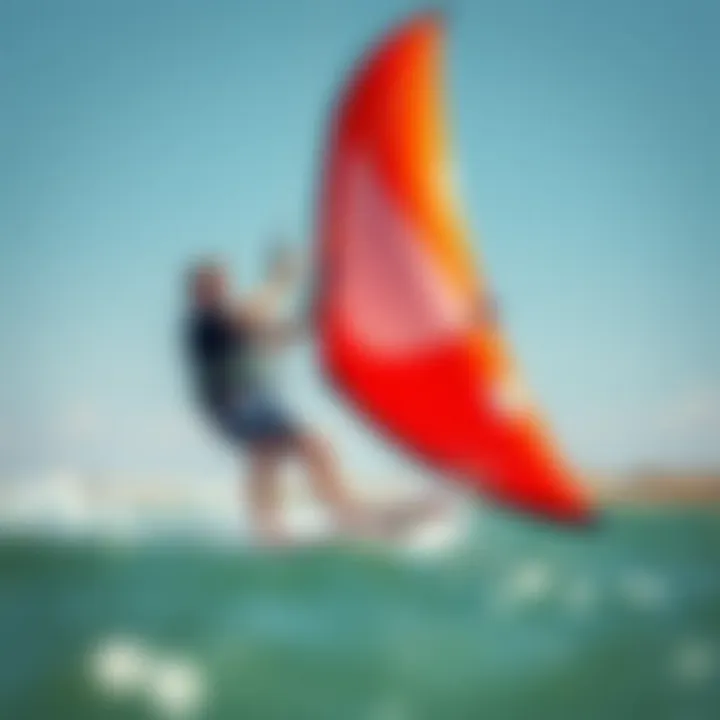
Online Tutorials and Videos
In today’s digital age, there's a treasure trove of online tutorials and videos available at one's fingertips. With just a few clicks, a beginner can uncover a world of instructional content. These visual and auditory resources can be an eye-opener.
Online platforms like YouTube host numerous channels dedicated to kitesurfing. Videos demonstrate everything from basic kite setup and launching techniques to advanced maneuvers. They can provide you with a clear visual guide, making it easier to understand complex skills. Additionally, these resources are beneficial for visual learners or those who appreciate real-time examples. Furthermore, tutorials often include handy tips scattered amid personal anecdotes that truly resonate with those new to the sport.
Here’s a curated list of what to look for while searching for online kitesurfing tutorials:
- Kite Setup: Learn how to properly set up your gear to ensure safety and functionality.
- Launching Techniques: Get step-by-step instructions on how to launch your kite effectively.
- Safety Briefings: Understand the various safety protocols to avoid accidents and ensure a smooth experience.
- Riding Techniques: Various tutorials capture the different riding techniques suited for various wind conditions.
Check out resources like YouTube or Reddit for community-shared experiences and insights.
Local Schools and Training Facilities
Nothing beats hands-on instruction when it comes to learning a sport. Hence, seeking out local schools and training facilities is a solid choice for beginners keen on mastering kitesurfing. Not only do these establishments offer structured lessons, but they also provide access to expert instructors who can guide newcomers through the intricacies of the sport safely.
Attending local classes allows beginners to receive personalized feedback and immediate corrections, something online resources cannot offer. Instructors can adapt the lessons according to your pace and needs, fostering a more enriched learning environment.
When choosing a school, consider these factors:
- Reputation: Look for institutions with positive reviews and testimonials from previous students.
- Instructor Qualification: Ensure that instructors have proper certifications and experience.
- Equipment Rental: Many schools provide equipment for their students, which can alleviate the need for significant upfront investment.
- Group Sizes: Smaller classes often allow for more personalized attention, speeding up the learning curve.
For those willing to invest time into getting proper training, local schools can be found through platforms like Facebook or by searching on .edu domains for accredited programs. Remember to check their websites for class schedules and pricing information.
Ultimately, the decision to utilize online tutorials, local kitesurfing schools, or a blend of both can significantly influence a beginner's experience and growth in this thrilling sport.
Caring for Your Kite
Taking proper care of your kite is crucial for any aspiring kitesurfer, especially for beginners. Neglecting even minor maintenance can lead to deterioration over time, impacting not only the kite's performance but also your overall kitesurfing experience. Let's delve into some practical aspects of kite care, understanding why it matters and how you can ensure your kite boasts a long lifespan.
A kite represents a significant investment, both financially and in terms of the time and effort you’ve put into learning the sport. Keeping your gear in good shape helps you maximize this investment. Beyond mere financials, a well-maintained kite performs better, making your ride smoother and safer. Here, we’ll discuss some essential maintenance tips and effective storage solutions to keep your kite in top-notch condition.
Maintenance Tips
Maintaining your kite doesn’t have to feel like rocket science. With a few habits and practices, you can keep your gear functioning like new. Consider these tips:
- Inspect Regularly: Always check your kite, lines, and bar before each session. Small dings or tears can escalate into bigger issues. Look for anything out of the ordinary, like frayed lines or fabric that’s starting to wear.
- Clean After Use: Saltwater, sand, and dirt can do a number on your kite. Rinse it with fresh water after each session to prevent salt and sand buildup. Avoid direct sunlight when rinsing; shade is your friend.
- Dry Properly: Never fold or store your kite while still wet. Moisture trapped inside can lead to mold or mildew, which can ruin the fabric. Hang it up or lay it flat to dry completely before putting it away.
- Repairs: If you notice small tears, repair them immediately. Most kites come with repair kits; learn how to patch up your kite in a pinch. It’s far cheaper than getting a new one.
"Neglecting kite maintenance can turn a great session into a headache. A little care goes a long way!"
Following these tips can keep your kite in peak condition, ensuring that each ride is enjoyable. The more you take care of your gear, the better your sessions will be.
Storage Solutions
Proper storage is as vital to kite care as regular maintenance. If you think about it, how you store your kite impacts its durability and longevity. Here are a few smart storage tips:
- Use a Bag: Get a dedicated kite bag. This not only protects your kite from physical damages but also makes it easier to transport. Avoid stacking heavy objects on top of your kite bag to prevent any crushing.
- Avoid Extreme Conditions: Store your kite in a climate-controlled environment if possible. Extreme temperatures can weaken the fabric over time. A cool, dry spot is ideal for storage.
- Fold with Care: When putting your kite away, fold it with the leading edge facing down. This can prevent creases that might affect performance later. A little effort in folding goes a long way toward maintaining its shape.
- Secure Lines: Store your lines separately from the kite. Untangle them and avoid wrapping them too tightly around the kite to prevent strain.
Utilizing these storage solutions ensures that when you're ready to hit the water, your kite is ready to perform to its fullest potential. Consider creating a checklist to integrate these practices into your routine, making kite care a stress-free experience.
By establishing effective maintenance and storage habits, you not only prolong the life of your kite, but also facilitate a more enjoyable kitesurfing experience. For more information on kite care, you might find resources at Wikipedia or community insights on platforms like Reddit helpful.
Epilogue
As we wrap up this comprehensive exploration of kitesurfing for beginners, it’s essential to reflect on why understanding your choices in kites is a game-changer. Choosing the right kite is akin to selecting the right tool for a job—get it right, and you’ll find yourself sailing smoothly; get it wrong, and you could be in for a rough ride.
Each aspect we covered, from kite size and material to local conditions and maintenance tips, serves a purpose in ensuring that newcomers not only learn effectively but also enjoy the sport safely. The characteristics of a good beginner kite, such as stability and ease of control, are crucial for those taking their first steps into this exhilarating sport. A kite that fits well with your skill level and local wind conditions can significantly reduce frustration and enhance your learning speed.
Ultimately, the right equipment, paired with the proper knowledge and safety considerations, lays the foundation for a pleasurable kitesurfing experience. Not only does it promote confidence on the water, but it also paves the way for growth into more advanced techniques down the line.
Recap of Key Points
- Understanding the right kite involves evaluating size, design, material, and how easy it is to control.
- Key features to look for in a beginner kite include stability and safety aspects, which help reduce accidents, allowing for focused learning.
- Assessing local conditions, such as wind patterns and water types, is vital for picking the right kite.
- Proper maintenance and storage of your kite promise longevity and performance.
- Exploring local schools or online resources provides invaluable learning opportunities for newcomers.
Next Steps for the Beginner Kitesurfer
- Practice Regularly - Start off in calm and safe environments to get the hang of handling your kite.
- Join Local Communities - This can offer support, knowledge sharing, and camaraderie when it comes to kitesurfing adventures.
- Take Lessons - If possible, consider formal training to establish a solid foundation in safe handling of the kite.
- Stay Informed - Keep learning about equipment updates, safety gear, and new skills that can enhance your kitesurfing experience.
- Enjoy the Journey - Remember, the thrill of kitesurfing is not just in the destination but also in the journey of mastering this exciting sport.
Learning to kiteboard is a thrilling adventure filled with both challenges and rewards. As you step onto the water, equipped with the knowledge and gear discussed, may your kites soar high and your spirit even higher.










